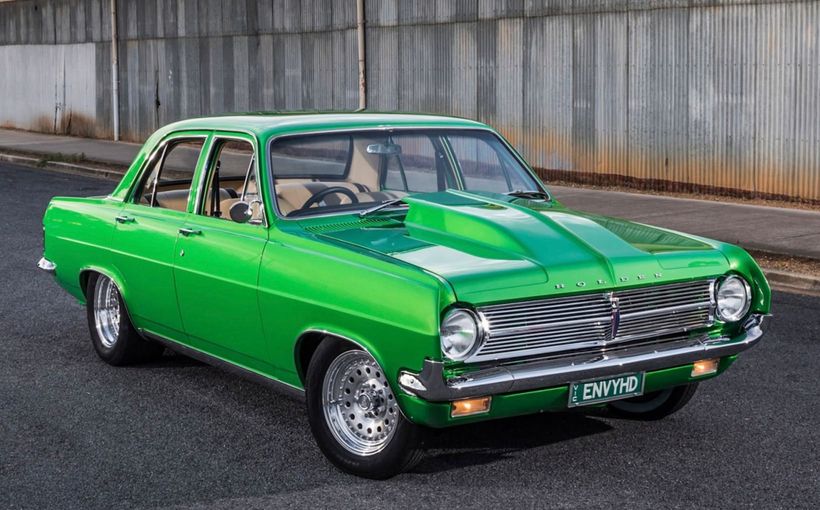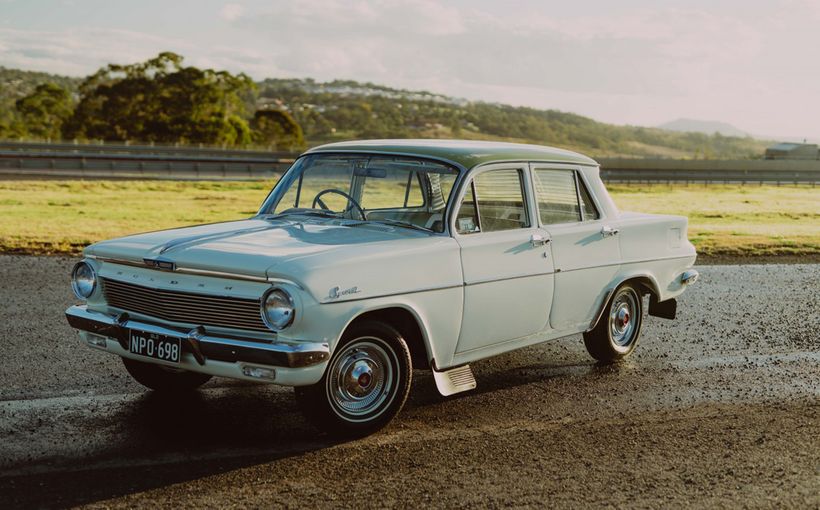Holden VR and VS Commodore: seeking acclaim for new emphasis on safety

It may seem difficult to believe now, but the 1993 VR was the first Commodore model to have a driver's airbag. Taking advantage of this feature, Holden's marketing executives conceived a new variant, the Acclaim, which packaged the three standout safety features on offer: airbag, independent rear suspension (IRS), anti-lock brakes (ABS) with automatic transmission. Cleverly aimed at both the fleet and private customer, the Acclaim was immediately successful and within weeks was accounting for 15 per cent of VR sales.

Safety was just emerging as a key priority for Australian consumers. Priced at $29,183, the Acclaim commanded a premium of about $4K over the spartan Executive. In July 1993 though, no-one could have predicted that within a decade multiple airbags would be standard on quite inexpensive cars and that a poor crash test rating would mean poor sales. So, in this respect, the VR Acclaim gestured towards the next century. There was no other car for anything like the price which offered the same number of overt safety features. Ford Australia and Holden became engaged in a kind of battle over safety and it’s fair to say the mid-1990s Commodores and Falcons offered much greater protection for their occupants than any of the earlier models.
Unfortunately, in many other respects the VR dated right back to 1988 and the car Holden’s advertising spruiked as the 'Big New V6 Commodore', the VN. The somewhat coarse pushrod 3.8-litre engine sat beneath the VR's new bonnet. It had a higher compression ratio for a modest increase in power from 127kW to 130, which looks pretty lowly by today's standards when anything less than 200 seems hardly worth quoting. While journalists complained about the engine’s roughness, few customers expressed concerns.

A better choice altogether was the venerable 5.0-litre V8. A Calais V8 with optional Howe leather upholstery was a far cry indeed from an entry level Commodore Executive V6 with live rear axle and obviously cutprice trim.
The overwhelming majority of VR Commodores were specified with the four-speed automatic transmission which, with its jerky changes, was no match for the unit fitted to Falcons of the day. The manual five-speed gearbox was preferred by enthusiasts.
A significant cosmetic makeover did make the VR look fresh. Its new grille paid homage to BMW's famous twin kidneys design, while the rounded rear wheel arches offended fewer sensibilities than the squared-off type seen on the VN and VR. The rethinking extended inside the cabin where a new dashboard gave more the impression of being change for the sake of change with few functional gains and a tendency to rattle into the bargain. Welcome though was a new steering wheel adjustable for rake and reach. Seatbelt webbing clamps were standard on all models, emphasising the priority on safety.
Holden’s safety engineer Laurie Sparke – working in consultation with academics at Monash University on crash survivability – did a superb job not only of making the Commodore safer but in highlighting safety as a major issue in the car-buying public’s mind.
The front and rear track were wider and 15-inch rims replaced 14s.
The 165kW V8 was carried over from the two previous models but a new 185kW version was now available at extra cost. (This engine enabled my HSV Statesman 185i to reach 100km/h in 7.2 seconds which was quickish by 1995 standards.)
Wheels magazine gave the VR Commodore range its Car of the Year Award, albeit by a slender margin from the Honda Accord. I have never forgotten the negative response to the Commodore's overall dynamics expressed to me by one judge at the celebratory dinner: a unanimous verdict it wasn't. There were 10 judges, five of whom voted for the Commodore, Four for the Accord and one for the Toyota Camry. 'A majority of judges felt the Commodore's value, economy, performance and features outpointed the Accord's obvious depth of refinement and attention to the nth degree of detail.' I'm sorry, Shannons Club members, but if I'd been a voter my choice would have been the poised Honda.
Nevertheless, editor Phil Scott had a point.
The clincher was Holden's sub-$30,000 model, the Acclaim... The Acclaim gave Holden the edge over Honda's indisputably better finished, more refined, but sedate performing and expensive Accord.
To buy the Commodore Acclaim's safety features in the Accord means spending a minimum $42,800 for the top range VTi-S version.
Reading the story, you could sense the angst behind granting this award to the VR Commodore:
Jingoism had no place either. Covering deficiencies with the national flag serves the buyer, and the COTY award, badly.
The Commodore's narrow margin of victory reflects both its strengths and its flaws. It does not have the peerless paint and panel finish of a top-ranking Japanese import. Interior plastics finish does not measure up to world's best practice either, there is still some coarseness about the engine and the suspension lacks BMW-style precision.
But those blemishes are largely cosmetic and do not reflect the underlying quality, durability and integrity of the package.
Guest judge Evan Green summed it up best when he likened the Commodore to a bargain priced suit, which was well-cut and made of good quality cloth, but whose buttons did not exactly match.

If the standard-wheelbase Commodore and Calais earned mainly faint praise, the same could not be said of the VR Statesman and Caprice which arrived in the first quarter of 1994. Of the VQ, which made its debut in early 1990, Wheels said:
Next to the stylish Fairlane/LTD twins, which share little with the EA Falcon beyond their door skins, Holden's luxury car looks like a half-baked effort.' By contrast, the VR Statesman/Caprice had a distinct, upmarket look. And the longer wheelbase removed much of the skittishness that characterised the standard cars, yes, even those equipped with the (relatively unsophisticated) Opel-type IRS. The steady decline of Fairlane/LTD sales - all the way through to their demise in late 2007 - dates to the introduction of the very successful VR luxury variants.
The VR Statesman’s longer wheelbase not only endowed it with a plusher ride but also gave it more surefooted handling. For the first time since the WB, Holden had a seriously impressive limousine to woo customers from the Ford Fairlane and LTD or even perhaps a 5-Series BMW. Because these Commodores were so light, the six-cylinder engine could be used effectively in the long-wheelbase cars.
IRS was not offered on the VR wagons and utes.
Interestingly, and despite being part of the COTY-winning lineup, the sporty six-cylinder S and V8 SS VR variants were less accomplished than their Falcon XR6 and XR8 rivals. Wheels asked Kevin Bartlett to test all four at Eastern Creek and both Fords were quicker. The XR6 was the pick of the four, benefitting from its extensive Tickford work over. By contrast, the Commodore S used a standard V6 engine. With a lap time of 2:07.1 the XR6 was four seconds faster.

Meanwhile, Holden Special Vehicles (HSV) continued to offer its hotter, more extroverted versions. The Maloo had carved out quite a niche for itself as Australia’s fastest ute. And there was a small following for HSV’s interpretation of the Statesman and Caprice. But I must admit to having quickly tired of my white car with its dull grey trim and it soon made way for a dubious 1989 Maserati 425i Biturbo (more exciting, probably quicker but dramatically less reliable!).
Unquestionably, the highly visible V8 Supercar racing helped VR and VS Commodore sales, as did the halo effect of HSV’s variants.

The most obvious weakness of the VR Commodore was the rudimentary V6. For the VS, which arrived in April 1995, the engine received a significant upgrade and a new name, Ecotech. Catchy, eh? This was a clumsy acronym for Emissions and Consumption Optimisation through TECHnology. Maximum power was now a more convincing 147kW. Interestingly, a supercharged edition of the V6 with 168kW was introduced as a Calais option during 1996.
In June 1996, the VS Series II was introduced. Now when a manual transmission was fitted behind the V6, this was a Getrag five-speed unit. The premium Calais scored 16-inch (alloy) wheels and recessed fog lamps. A supercharged 165kW edition of the Ecotech engine became optional on the Calais later that year.

Holden's performance counterpart, Holden Special Vehicles, was also hard at work on its cars. A stroked 5.7-litre V8 engine, the 215i, promised acceleration times comparable with an XY Falcon GTHO. Big news, too, was the inclusion of BT-R's advanced Hydratrak differential on HSV's 215i-equipped cars. This is best understood as a cartridge-type fluid coupling which progressively increases torque transfer to the wheel rotating more slowly.

HSV's star attraction at the 1995 Sydney motor show was the GTS-R in Melbourne yellow taxi paintwork with the 215i powertrain, over-the-top rear spoiler and a generally wild child demeanour; pity a standard WRX was quicker! The price was $75,000 or $85,000 if you specified a blueprinted engine with somewhere between 15 and 20 extra kiloWatts. The hyphen-R, of course, was for Racing. But for all the hype and hyphen, it only managed 15 seconds flat for the standing 400 metres. (I was on the staff of MOTOR magazine from late 1996 to mid-1999 and our favourite covers showed HSV's proudest efforts being beaten by Subeys and Lancer Evolutions. It was also the case that sales of the magazine went up whenever an HSV was shown on the cover, a fact well understood by we journalists.)

The main reason why the VR/VS Commodores seemed to date so quickly can be summed up in two letters: VT. This next model was so much more elegant and sophisticated – so universally appealing that it gained the Commodore what would prove to be a permanent sales supremacy over the Falcon – that it rendered those predecessors instantly out of date.
While few observers would rate the VR/VS Commodores highly on aesthetics, they sold really well and the VR broke the long precedent of requiring hefty factory bonuses from the start of the runout phase. But once the VT was available resale values of VR and VS Commodores dropped sharply. The same thing happened to the VT with strong sales leading to glut of used examples within a few years of launch.
The VR and VS Commodores do not number among my favourite Commodores, but even so, it would be great to have a (blueprinted) GTS-Rs in the shed...












